Realization of Sustainable Development Goals with Disruptive Technologies by Integrating Industry 5.0, Society 5.0, Smart Cities and Villages
Abstract
1. Introduction
2. The Role of Disruptive Technologies in Sustainable Development Goals
2.1. SDG 3 (Good Health and Wellbeing)
2.1.1. Disaster Management—A Case Study of the COVID-19 Pandemic
- Empathetic branding: The customers must be supported through empathetic communication strategies and assisted immediately during the COVID-19 pandemic. The brand should be established while the purpose of the organization should be promulgated to the customers. Campaigns should be run, and brand sentiment analysis should be conducted to understand the pulse of the market and the role played in it. Digital marketing and nano-targeting will be the enablers of this empathetic branding;
- Digitalized business models: The e-com relationships should be strengthened, while the emphasis should be placed on customer segments and active channels. The business processes must be verified for compliance with regulatory bodies. The network must be strengthened such that, even in the event of digital storms, businesses could easily continue to support clients and customers. Revenue streams must be found for the company to maintain sustainable growth. The next step would be to have direct, online sale platforms where a quality service is provided to the customers without the need for intermediaries. Automated help centers should be built to eliminate the presence of human support. The enablers for this would be digital adoption, direct-to-customer and drone deliveries;
- Remote collaboration: The employment model of working from home should be encouraged. Any tasks which do not add value or involve too many physical movements must be reviewed for their importance. Instead of this, cheap automated solutions can be considered as an alternative. The emerging technologies and automation can be leveraged to avoid the risks of contact with people. Remote sales, in the case of B2B, can make use of VR-like technologies to create a long-lasting impression while also accomplishing business deals. Vendors can be sought out in case of over-flow or short-term surge in demand. Remote working and the gig culture are the enablers in this regard;
- Virtualized sales and service: After-sale service models should be revisited to provide support to clients in the most feasible manner. The sales team should be managed with agility in which their roles are reinvented, involving restructuring and clear communication. The next action plan should be to increase the network capacity for increasing the digital sales’ demand. The call center executives should be provided with a virtual network in which they can access resources anywhere at any time. AR or visual search can be considered when there is a fault to be addressed. The enablers are chatbots, home contact centers, online sales and e-service.
2.1.2. Healthcare Transformation with Disruptive Technologies
2.2. SDG 8 (Decent Work and Economic Growth)
2.2.1. Disruptive Technologies in Nature-Inclusive Business Model
2.2.2. Overview of New Age Technology Market Potential
- Artificial Intelligence: For the period 2019–2023, the global market size for artificial intelligence (AI) is expected to growth by USD 75.54 billion. According to the prediction by McKinsey, the production capacity of AI would be higher than that of the steam engines of the 1800s. The impact of AI on the global economy will be as much as 13 trillion USD by the year 2030, as per the report published by McKinsey [30]. AI is expected to add up to 1.2 per cent of GDP growth every year up to 2030. By 2022, 30% of all the cyber-attacks upon AI will target and exploit training-data poisoning, AI model theft or adversarial samples to attack AI-powered systems [31];
- Big Data Analytics: The Big Data analytics market is set to reach 275 billion USD by 2023, according to a research report. This also predicted a CAGR growth of 12 per cent between 2017 and 2023. This report also suggested that the top players in Big Data analytics would be IBM, Microsoft, Oracle, SAP, SAS Institute Inc., etc. [29];
- Drones: The growth of the drone market size across the globe is valued at 13.37 billion USD by December 2025. The expected CAGR growth will be 13.70 per cent according to the report published. The primary factors that drive this growth rate would be cost-effectiveness, accuracy and the ability to execute dangerous tasks such as inspecting utility pipelines. There is a way forward for the appropriate implementation of commercial drone services and framing the regulatory policies for the proper usage of drones. Awareness about UAVs must be created. A total of the top 100 drone companies were organized into categories by UAV Coach, based on their core service offerings using drones [29];
- Robotics: The report published in this area predicted the CAGR growth to be 26 per cent while the turnaround will be 210 billion USD by the year 2025. By the year 2020, the market is set to reach 100 billion USD. Attending to the industry reports, the industry is going to be flooded with cloud-based robot services. Furthermore, in the next five years, small and medium-sized companies will also start hiring robots based on their needs, thus creating new demand drivers. The authors of [32,33] conducted a study on End-User Development (EUD) for personalized applications, humanoid robots and IoT. They concluded with a possible research agenda applicable to the field. The presented conceptual framework facilitated a better understanding of the concepts involved and which factors should be considered in the designing of EUD environments for IoT and/or robots. This framework can also be used as a standard for conducting comparative analysis among different approaches and identifying novel discussion areas for further research. This technology tends to make robots perform tasks and missions by themselves, as illustrated by the authors of [34] who decoded the state-of-the-art techniques available for AI, its advantages and drawbacks and the future of the technology;
- Cybersecurity: By 2026, the market size for Cyber Security across the globe would be 345.42 billion USD while it is predicted to grow at a rate of 12.3 percent CAGR between 2018 and 2026. The cybersecurity industry will become the much-needed one due to increasing cyberattacks, malware, phishing threads and increasing adoption of IoT and bring your own device (BYOD) trends. The report further recommends that the encryption solutions’ segment is predicted to have significant market growth in this forecast period. By the year 2023, blockchain is expected to scale in technical viewpoints and is expected to support private transactions with the confidentiality of data preserved [31];
- Robotic Process Automation: According to Gartner, the Robotic Process Automation (RPA) delivered as a package with application integration is predicted to grow by 40% every year up to 2022. Furthermore, the market size of RPA across the globe is predicted to grow up to 3.97 billion USD by 2025 while its CAGR is predicted to be 31.1 percent. A few of the notable industry players would be Automation Anywhere, Inc.; Blue Prism Group Plc; UiPath; Be Informed B.V.; OpenSpan; and Jacada, Inc. [29];
- Cloud Computing: The market size of cloud computing was valued at 36.7 billion USD by 2018 and is expected to be USD 285.3 billion by 2025 with a 29.2 CAGR. Few notable players in the industry are Amazon Web Services, IBM, Salesforce, Aliyun, SAP, Google Cloud Platform, Oracle, Rackspace, Microsoft Azure, VMware Inc, Dell Inc, GIANT and EMC [29];
- IoT: The IoT market has some key players such as Facebook, Hewlett Packard Enterprise, Microsoft, Dell Technologies, Apple, Intel Corporation, Google and Cisco. With a market value of 190 billion USD in 2018, the IoT (Internet of Things) market across the globe is expected to achieve 1111.3 billion USD by 2026 with a 24.7 per cent CAGR [29];
- Augmented reality and virtual reality (AR/VR): Global Augmented and in the year 2017, the market size of augmented virtual reality was recorded at 11.32 billion USD across the globe. It is projected to reach a CAGR growth of 63.3 percent from 2018 to 2025 while the total market share would be 571.42 billion USD. Prominent players in this market are Astrobotic, Swedish Space Corporation, Maxar Technologies Inc., Vector Launch Inc., Firefly Aerospace, BLUE ORIGIN and Virgin Galactic. In the year 2023, 30% of IT organizations are expected to proceed with the expansion of BYOD policies into “bring your own enhancement” (BYOE) to address the augmented humans in the workforce, as per Gartner [29,31];
- Autonomous Vehicle: Reports suggest that the autonomous vehicle market across the globe was yielding 54.23 billion USD in the year 2019. It is predicted to increase up to 556.67 billion USD by the year 2026 with 39.47 CAGR growth from 2019 to 2026. The prominent players in this market are Daimler AG, Ford Motor Company, Volkswagen Group, General Motors, Renault–Nissan–Mitsubishi alliance, AB Volvo, Volvo–Autoliv–Ericsson–Zenuity alliance, Groupe SA, Tesla Inc, BMW AG and Toyota Motor Corporation [29,31].
2.3. SDG 9 (Industry, Innovation and Infrastructure)
2.3.1. Industry 5.0
2.3.2. Technology Supporting Innovation and Product Development
2.4. SDG 11 (Sustainable Cities and Communities)
Society 5.0
2.5. Other SDGs
3. Smart Cities and Villages as a Product of Integrated Disruptive Technologies
4. Integration of New Age Technology for Achieving SDGs Framework
5. Discussion and Conclusions
Author Contributions
Funding
Institutional Review Board Statement
Informed Consent Statement
Data Availability Statement
Conflicts of Interest
References
- Moyer, J.D.; Hedden, S. Are we on the right path to achieve the sustainable development goals? World Dev. 2020, 127, 104749. [Google Scholar] [CrossRef]
- Giller, K.E.; Drupady, I.M.; Fontana, L.B.; Oldekop, J.A. Editorial overview: The SDGs—Aspirations or inspirations for global sustainability. Curr. Opin. Environ. Sustain. 2018, 34, A1–A2. [Google Scholar] [CrossRef]
- Bennich, T.; Weitz, N.; Carlsen, H. Deciphering the scientific literature on SDG interactions: A review and reading guide. Sci. Total Environ. 2020, 728, 138405. [Google Scholar] [CrossRef]
- Abe, S. For Future Growth, for Future Generations, and for a Future Japan That Is Robust. 2018. Available online: https://www.japan.go.jp/abenomics/_userdata/abenomics/pdf/2001_abenomics.pdf (accessed on 26 September 2022).
- Society 5.0 (2018-11-13). Available online: https://www.keidanren.or.jp/en/policy/2018/095.html (accessed on 1 November 2022).
- Elavarasan, R.M.; Pugazhendhi, R.; Shafiullah, G.M.; Kumar, N.M.; Arif, M.T.; Jamal, T.; Chopra, S.S.; Dyduch, J. Impacts of COVID-19 on Sustainable Development Goals and Effective Approaches to Maneuver Them in the Post-Pandemic Environment. Environ. Sci. Pollut. Res. 2022, 29, 33957–33987. [Google Scholar] [CrossRef]
- Pradhan, P.; Costa, L.; Rybski, D.; Lucht, W.; Kropp, J.P. A Systematic Study of Sustainable Development Goal (SDG) Interactions. Earth’s Future 2017, 5, 1169–1179. [Google Scholar] [CrossRef]
- Madurai Elavarasan, R.; Pugazhendhi, R.; Jamal, T.; Dyduch, J.; Arif, M.T.; Manoj Kumar, N.; Shafiullah, G.; Chopra, S.S.; Nadarajah, M. Envisioning the UN Sustainable Development Goals (SDGs) through the Lens of Energy Sustainability (SDG 7) in the Post-COVID-19 World. Appl. Energy 2021, 292, 116665. [Google Scholar] [CrossRef]
- Kumar, N.M.; Chopra, S.S.; Chand, A.A.; Elavarasan, R.M.; Shafiullah, G.M. Hybrid Renewable Energy Microgrid for a Residential Community: A Techno-Economic and Environmental Perspective in the Context of the SDG7. Sustainability 2020, 12, 3944. [Google Scholar] [CrossRef]
- Madurai Elavarasan, R.; Pugazhendhi, R.; Irfan, M.; Mihet-Popa, L.; Campana, P.E.; Khan, I.A. A Novel Sustainable Development Goal 7 Composite Index as the Paradigm for Energy Sustainability Assessment: A Case Study from Europe. Appl. Energy 2022, 307, 118173. [Google Scholar] [CrossRef]
- Madurai Elavarasan, R.; Pugazhendhi, R.; Irfan, M.; Mihet-Popa, L.; Khan, I.A.; Campana, P.E. State-of-The-Art Sustainable Approaches for Deeper Decarbonization in Europe—An Endowment to Climate Neutral Vision. Renew. Sustain. Energy Rev. 2022, 159, 112204. [Google Scholar] [CrossRef]
- SDG Resource Centre—Leading-Edge Information on the Sustainable Development Goals. Available online: https://sdgresources.relx.com/ (accessed on 14 November 2022).
- Schuelke-Leech, B.-A. Disruptive Technologies for a Green New Deal. Curr. Opin. Environ. Sci. Health 2021, 21, 100245. [Google Scholar] [CrossRef]
- Rowan, N.J.; Casey, O. Empower Eco Multi-Actor HUB: A Triple Helix “Academia-Industry-Authority” Approach to Creating and Sharing Potentially Disruptive Tools for Addressing Novel and Emerging New Green Deal Opportunities under a United Nations’ Sustainable Development Goals Framework. Curr. Opin. Environ. Sci. Health 2021, 21, 100254. [Google Scholar] [CrossRef]
- Aysan, A.F.; Bergigui, F.; Disli, M. Blockchain-Based Solutions in Achieving SDGs after COVID-19. J. Open Innov. Technol. Mark. Complex. 2021, 7, 151. [Google Scholar] [CrossRef]
- Nagaraj, S.V. Disruptive Technologies That Are Likely to Shape Future Jobs. Procedia Comput. Sci. 2020, 172, 502–504. [Google Scholar] [CrossRef]
- Gejendhiran, S.; Anicia, S.A.; Vignesh, S.; Kalaimani, M. Disruptive Technologies—A Promising Key for Sustainable Future Education. Procedia Comput. Sci. 2020, 172, 843–847. [Google Scholar] [CrossRef]
- Hopster, J. What Are Socially Disruptive Technologies? Technol. Soc. 2021, 67, 101750. [Google Scholar] [CrossRef]
- Park, W.Y.; Shah, N.; Shiraishi, K.; Vine, E. Improving Energy Performance Metrics to Maximize the Benefits of Disruptive Technologies. Energy Res. Soc. Sci. 2022, 89, 102678. [Google Scholar] [CrossRef]
- Munawar, H.S.; Mojtahedi, M.; Hammad, A.W.A.; Kouzani, A.; Mahmud, M.A.P. Disruptive Technologies as a Solution for Disaster Risk Management: A Review. Sci. Total Environ. 2021, 806, 151351. [Google Scholar] [CrossRef]
- Shiroishi, Y.; Uchiyama, K.; Suzuki, N. Society 5.0: For Human Security and Well-Being. Computer 2018, 51, 91–95. [Google Scholar] [CrossRef]
- Mourtzis, D.; Angelopoulos, J.; Panopoulos, N. A Literature Review of the Challenges and Opportunities of the Transition from Industry 4.0 to Society 5.0. Energies 2022, 15, 6276. [Google Scholar] [CrossRef]
- Huang, S.; Wang, B.; Li, X.; Zheng, P.; Mourtzis, D.; Wang, L. Industry 5.0 and Society 5.0—Comparison, complementation and co-evolution. J. Manuf. Syst. 2022, 64, 424–428. [Google Scholar] [CrossRef]
- Ghobakhloo, M.; Iranmanesh, M.; Mubarak, M.F.; Mubarik, M.; Rejeb, A.; Nilashi, M. Identifying industry 5.0 contributions to sustainable development: A strategy roadmap for delivering sustainability values. Sustain. Prod. Consum. 2022, 33, 716–737. [Google Scholar] [CrossRef]
- Elavarasan, R.M.; Pugazhendhi, R.; Shafiullah, G.M.; Irfan, M.; Anvari-Moghaddam, A. A Hover View over Effectual Approaches on Pandemic Management for Sustainable Cities—The Endowment of Prospective Technologies with Revitalization Strategies. Sustain. Cities Soc. 2021, 68, 102789. [Google Scholar] [CrossRef]
- Madurai Elavarasan, R.; Pugazhendhi, R. Restructured Society and Environment: A Review on Potential Technological Strategies to Control the COVID-19 Pandemic. Sci. Total Environ. 2020, 725, 138858. [Google Scholar] [CrossRef]
- Attenborough, S.D. Nature Risk Rising: Why the Crisis Engulfing Nature Matters for Business and the Economy; World Economic Forum: Geneva, Switzerland, 2020. [Google Scholar]
- Franco, E.G. The Global Risks Report 2020; World Economic Forum: Geneva, Switzerland, 2020. [Google Scholar]
- Srivastava, S. Top 10 New-Age Technologies Market Prediction For Upcoming Years. Available online: https://www.analyticsinsight.net/top-10-new-age-technologies-market-prediction-upcoming-years/ (accessed on 18 December 2019).
- Gonzalo, A.; Harreis, H.; Altable, C.S.; Villepelet, C. Fashion’s Digital Transformation: Now or Never; Textile Future: Chicago, IL, USA, 2020. [Google Scholar]
- Cearley, D.W. Top 10 Strategic Technology Trends for 2020; Gartner: Stamford, CT, USA, 2020. [Google Scholar]
- Leonardi, N.; Manca, M.; Paternò, F.; Santoro, C. Trigger-Action Programming for Personalising Humanoid Robot Behaviour. In Proceedings of the 2019 CHI Conference on Human Factors in Computing Systems—CHI ’19, Glasgow, UK, 4–9 May 2019; ACM Press: New York, NY, USA, 2019; pp. 1–13. [Google Scholar]
- Paternò, F.; Manca, M.; Santoro, C. End User Personalization of Social Humanoid Robots. 2019. Available online: https://www.google.com.hk/url?sa=t&rct=j&q=&esrc=s&source=web&cd=&cad=rja&uact=8&ved=2ahUKEwilvaGXnbT7AhVGsFYBHRdMA04QFnoECAkQAQ&url=https%3A%2F%2Fceur-ws.org%2FVol-2503%2Fpaper1_13.pdf&usg=AOvVaw0J2AajRF5GBO7VizCIheA9 (accessed on 26 September 2022).
- Obschonka, M.; Audretsch, D.B. Artificial intelligence and big data in entrepreneurship: A new era has begun. Small Bus. Econ. 2019, 55, 529–539. [Google Scholar] [CrossRef]
- Aceto, G.; Persico, V.; Pescapé, A. Industry 4.0 and Health: Internet of Things, Big Data, and Cloud Computing for Healthcare 4.0. J. Ind. Inf. Integr. 2020, 18, 100129. [Google Scholar] [CrossRef]
- Aggarwal, P.K.; Jarvis, A.; Campbell, B.M.; Zougmoré, R.B.; Khatri-Chhetri, A.; Vermeulen, S.J.; Loboguerrero, A.M.; Sebastian, L.S.; Kinyangi, J.; Bonilla-Findji, O.; et al. The climate-smart village approach: Framework of an integrative strategy for scaling up adaptation options in agriculture. Ecol. Soc. 2018, 23, art14. [Google Scholar] [CrossRef]
- Hahn, K. Opportunities for Socially Responsible Industry 4.s. IEEE Eng. Manag. Rev. 2020, 48, 63–70. [Google Scholar] [CrossRef]
- Lu, Y. Industry 4.0: A survey on technologies, applications and open research issues. J. Ind. Inf. Integr. 2017, 6, 1–10. [Google Scholar] [CrossRef]
- Ortiz, J.H.; Marroquin, W.G.; Cifuentes, L.Z. Industry 4.0: Current Status and Future Trends. In Industry 4.0—Current Status and Future Trends; IntechOpen: London, UK; Rijeka, Croatia, 2020. [Google Scholar]
- Cho, M.; Lai, L.; Xu, W. Distributed Dual Coordinate Ascent in General Tree Networks and Communication Network Effect on Synchronous Machine Learning. IEEE J. Sel. Areas Commun. 2021, 39, 2105–2119. [Google Scholar] [CrossRef]
- Janssen, C.P.; Donker, S.F.; Brumby, D.P.; Kun, A.L. History and future of human-automation interaction. Int. J. Hum. Comput. Stud. 2019, 131, 99–107. [Google Scholar] [CrossRef]
- Özdemir, V.; Hekim, N. Birth of Industry 5.0: Making Sense of Big Data with Artificial Intelligence, “The Internet of Things” and Next-Generation Technology Policy. Omi. A J. Integr. Biol. 2018, 22, 65–76. [Google Scholar] [CrossRef] [PubMed]
- Fox, S.J. Policing—The technological revolution: Opportunities & challenges! Technol. Soc. 2019, 56, 69–78. [Google Scholar] [CrossRef]
- Parayil, G. Mapping technological trajectories of the Green Revolution and the Gene Revolution from modernization to globalization. Res. Policy 2003, 32, 971–990. [Google Scholar] [CrossRef]
- Sabourin, V. Technological revolutions and the formation of strategic groups. J. Eng. Technol. Manag. 1999, 16, 271–293. [Google Scholar] [CrossRef]
- Roblek, V.; Meško, M.; Krapež, A. A Complex View of Industry 4.0. SAGE Open 2016, 6, 215824401665398. [Google Scholar] [CrossRef]
- Atluri, V.; Eaton, J.; Kamat, M.; Rao, S.; Sahni, S. Tech-Enabled Disruption of Products and Services: The New Battleground for Industrial Companies. McKinsey Co. 2018. Available online: https://www.mckinsey.com/capabilities/mckinsey-digital/our-insights/tech-enabled-disruption-of-products-and-services (accessed on 26 September 2022).
- Schuelke-Leech, B.-A. A model for understanding the orders of magnitude of disruptive technologies. Technol. Forecast. Soc. Chang. 2018, 129, 261–274. [Google Scholar] [CrossRef]
- Foresti, R.; Rossi, S.; Magnani, M.; Guarino Lo Bianco, C.; Delmonte, N. Smart Society and Artificial Intelligence: Big Data Scheduling and the Global Standard Method Applied to Smart Maintenance. Engineering 2020, 6, 835–846. [Google Scholar] [CrossRef]
- Fukuda, K. Science, technology and innovation ecosystem transformation toward society 5.0. Int. J. Prod. Econ. 2020, 220, 107460. [Google Scholar] [CrossRef]
- Fukuyama, M. Society 5.0: Aiming for a New Human-Centered Society. Jpn. Spotlight 2018, 1, 47–50. [Google Scholar]
- Gladden, M.E. Who Will Be the Members of Society 5.0? Towards an Anthropology of Technologically Posthumanized Future Societies. Soc. Sci. 2019, 8, 148. [Google Scholar] [CrossRef]
- Harayama, Y. Aiming for a new human-centered society. Collaborative creation through global R&D open innovation for creating the future. Hitachi Rev. 2017, 66, 8–13. [Google Scholar]
- Mavrodieva, A.V.; Shaw, R. Disaster and Climate Change Issues in Japan’s Society 5.0—A Discussion. Sustainability 2020, 12, 1893. [Google Scholar] [CrossRef]
- Salimova, T.; Guskova, N.; Krakovskaya, I.; Sirota, E. From industry 4.0 to Society 5.0: Challenges for sustainable competitiveness of Russian industry. IOP Conf. Ser. Mater. Sci. Eng. 2019, 497, 012090. [Google Scholar] [CrossRef]
- Ferreira, C.M.; Serpa, S. Society 5.0 and Social Development: Contributions to a Discussion. Manag. Organ. Stud. 2018, 5, 26. [Google Scholar] [CrossRef]
- Nieuważny, J.; Masui, F.; Ptaszynski, M.; Rzepka, R.; Nowakowski, K. How religion and morality correlate in age of society 5.0: Statistical analysis of emotional and moral associations with Buddhist religious terms appearing on Japanese blogs. Cogn. Syst. Res. 2020, 59, 329–344. [Google Scholar] [CrossRef]
- Grunwitz, K. The future is Society 5.0. Comput. Fraud Secur. 2019, 2019, 20. [Google Scholar] [CrossRef]
- Nagy, K.; Hajrizi, E. Building Pillars for Adapting Society 5.0 in Post-Conflict Countries. IFAC-PapersOnLine 2019, 52, 40–45. [Google Scholar] [CrossRef]
- Shiroishi, Y.; Uchiyama, K.; Suzuki, N. Better Actions for Society 5.0: Using AI for Evidence-Based Policy Making That Keeps Humans in the Loop. Computer 2019, 52, 73–78. [Google Scholar] [CrossRef]
- Fozer, D.; Sziraky, F.Z.; Racz, L.; Nagy, T.; Tarjani, A.J.; Toth, A.J.; Haaz, E.; Benko, T.; Mizsey, P. Life cycle, PESTLE and Multi-Criteria Decision Analysis of CCS process alternatives. J. Clean. Prod. 2017, 147, 75–85. [Google Scholar] [CrossRef]
- Mcmanus, J.; Li, M.; Moitra, D. India: A PESTEL Analysis; Chandos Asian Studies Series; Chandos Publishing: London, UK, 2007; pp. 37–56. [Google Scholar] [CrossRef]
- Wan, C.; Lin, J.; Wang, J.; Song, Y.; Dong, Z.Y. Direct Quantile Regression for Nonparametric Probabilistic Forecasting of Wind Power Generation. IEEE Trans. Power Syst. 2017, 32, 2767–2778. [Google Scholar] [CrossRef]
- Fennell, S.; Kaur, P.; Jhunjhunwala, A.; Narayanan, D.; Loyola, C.; Bedi, J.; Singh, Y. Examining linkages between Smart Villages and Smart Cities: Learning from rural youth accessing the internet in India. Telecomm. Policy 2018, 42, 810–823. [Google Scholar] [CrossRef]
- D’Aniello, G.; Gaeta, M.; Orciuoli, F.; Sansonetti, G.; Sorgente, F. Knowledge-Based Smart City Service System. Electronics 2020, 9, 965. [Google Scholar] [CrossRef]
- Neirotti, P.; De Marco, A.; Cagliano, A.C.; Mangano, G.; Scorrano, F. Current trends in Smart City initiatives: Some stylised facts. Cities 2014, 38, 25–36. [Google Scholar] [CrossRef]
- Varghese, P. Exploring Other Concepts of Smart-Cities within the Urbanising Indian Context. Procedia Technol. 2016, 24, 1858–1867. [Google Scholar] [CrossRef][Green Version]
- Zoomers, A.; van Noorloos, F.; Otsuki, K.; Steel, G.; van Westen, G. The Rush for Land in an Urbanizing World: From Land Grabbing Toward Developing Safe, Resilient, and Sustainable Cities and Landscapes. World Dev. 2017, 92, 242–252. [Google Scholar] [CrossRef]
- Nam, T.; Pardo, T.A. Conceptualizing smart city with dimensions of technology, people, and institutions. In Proceedings of the 12th Annual International Digital Government Research Conference on Digital Government Innovation in Challenging Times—dg.o ’11, College Park, MD, USA, 12–15 June 2011; ACM Press: New York, NY, USA, 2011; p. 282. [Google Scholar]
- Ahad, M.A.; Paiva, S.; Tripathi, G.; Feroz, N. Enabling technologies and sustainable smart cities. Sustain. Cities Soc. 2020, 61, 102301. [Google Scholar] [CrossRef]
- Quijano-Sánchez, L.; Cantador, I.; Cortés-Cediel, M.E.; Gil, O. Recommender systems for smart cities. Inf. Syst. 2020, 92, 101545. [Google Scholar] [CrossRef]
- Angelidou, M. Smart city policies: A spatial approach. Cities 2014, 41, S3–S11. [Google Scholar] [CrossRef]
- Lu, H.-P.; Chen, C.-S.; Yu, H. Technology roadmap for building a smart city: An exploring study on methodology. Future Gener. Comput. Syst. 2019, 97, 727–742. [Google Scholar] [CrossRef]
- Mackenzie, D. IEEE Smart Village: Sustainable Development Is a Global Mission. IEEE Syst. Man Cybern. Mag. 2019, 5, 39–41. [Google Scholar] [CrossRef]
- Mishra, B.K.; Sahoo, A.K.; Misra, R. Recommendation for Selecting Smart Village in India Through Opinion Mining Using Big Data Analytics. In ICT Based Innovations; Springer: Singapore, 2018; pp. 105–112. [Google Scholar]
- Amitabh, U. This Is How India Created Its First “Smart Village”. 3 October 2016. Available online: https://www.weforum.org/agenda/2016/10/india-creates-first-smart-village/ (accessed on 26 September 2022).
- Aziiza, A.A.; Susanto, T.D. The Smart Village Model for Rural Area (Case Study: Banyuwangi Regency). IOP Conf. Ser. Mater. Sci. Eng. 2020, 722, 012011. [Google Scholar] [CrossRef]
- Hess, S.; Kolosy, K.; O’Hara, E.; Paneva, V.; Soto, P. Smart Villages Revitalising Rural Services; Intelligent Community Forum: Brussels, Belgium, 2018. [Google Scholar]
- Komorowski, Ł.; Stanny, M. Smart Villages: Where Can They Happen? Land 2020, 9, 151. [Google Scholar] [CrossRef]
- Bleischwitz, R.; Spataru, C.; VanDeveer, S.D.; Obersteiner, M.; van der Voet, E.; Johnson, C.; Andrews-Speed, P.; Boersma, T.; Hoff, H.; van Vuuren, D.P. Resource nexus perspectives towards the United Nations Sustainable Development Goals. Nat. Sustain. 2018, 1, 737–743. [Google Scholar] [CrossRef]
- Chang, Y.; Li, G.; Yao, Y.; Zhang, L.; Yu, C. Quantifying the Water-Energy-Food Nexus: Current Status and Trends. Energies 2016, 9, 65. [Google Scholar] [CrossRef]
- Kaddoura, S.; El Khatib, S. Review of water-energy-food Nexus tools to improve the Nexus modelling approach for integrated policy making. Environ. Sci. Policy 2017, 77, 114–121. [Google Scholar] [CrossRef]
- Liu, J.; Hull, V.; Godfray, H.C.J.; Tilman, D.; Gleick, P.; Hoff, H.; Pahl-Wostl, C.; Xu, Z.; Chung, M.G.; Sun, J.; et al. Nexus approaches to global sustainable development. Nat. Sustain. 2018, 1, 466–476. [Google Scholar] [CrossRef]
- van Gevelt, T.; Canales Holzeis, C.; Fennell, S.; Heap, B.; Holmes, J.; Hurley Depret, M.; Jones, B.; Safdar, M.T. Achieving universal energy access and rural development through smart villages. Energy Sustain. Dev. 2018, 43, 139–142. [Google Scholar] [CrossRef]
- The Commonwealth. Curriculum Framework for Enabling the Sustainable Development Goals; The Commonwealth: London, UK, 2017. [Google Scholar]
- Klemeš, J.J.; Van Fan, Y.; Tan, R.R.; Jiang, P. Minimising the present and future plastic waste, energy and environmental footprints related to COVID-19. Renew. Sustain. Energy Rev. 2020, 127, 109883. [Google Scholar] [CrossRef]
- OECD. The Sustainable Development Goals: An Overview of Relevant OECD Analysis, Tools and Approaches; Science Direct: Paris, France, 2018. [Google Scholar]
- Sharma, S.; Zhang, M.; Anshika; Gao, J.; Zhang, H.; Kota, S.H. Effect of restricted emissions during COVID-19 on air quality in India. Sci. Total Environ. 2020, 728, 138878. [Google Scholar] [CrossRef]
- Turkyilmaz, A.; Guney, M.; Karaca, F.; Bagdatkyzy, Z.; Sandybayeva, A.; Sirenova, G. A Comprehensive Construction and Demolition Waste Management Model using PESTEL and 3R for Construction Companies Operating in Central Asia. Sustainability 2019, 11, 1593. [Google Scholar] [CrossRef]
- Zambrano-Monserrate, M.A.; Ruano, M.A.; Sanchez-Alcalde, L. Indirect effects of COVID-19 on the environment. Sci. Total Environ. 2020, 728, 138813. [Google Scholar] [CrossRef]
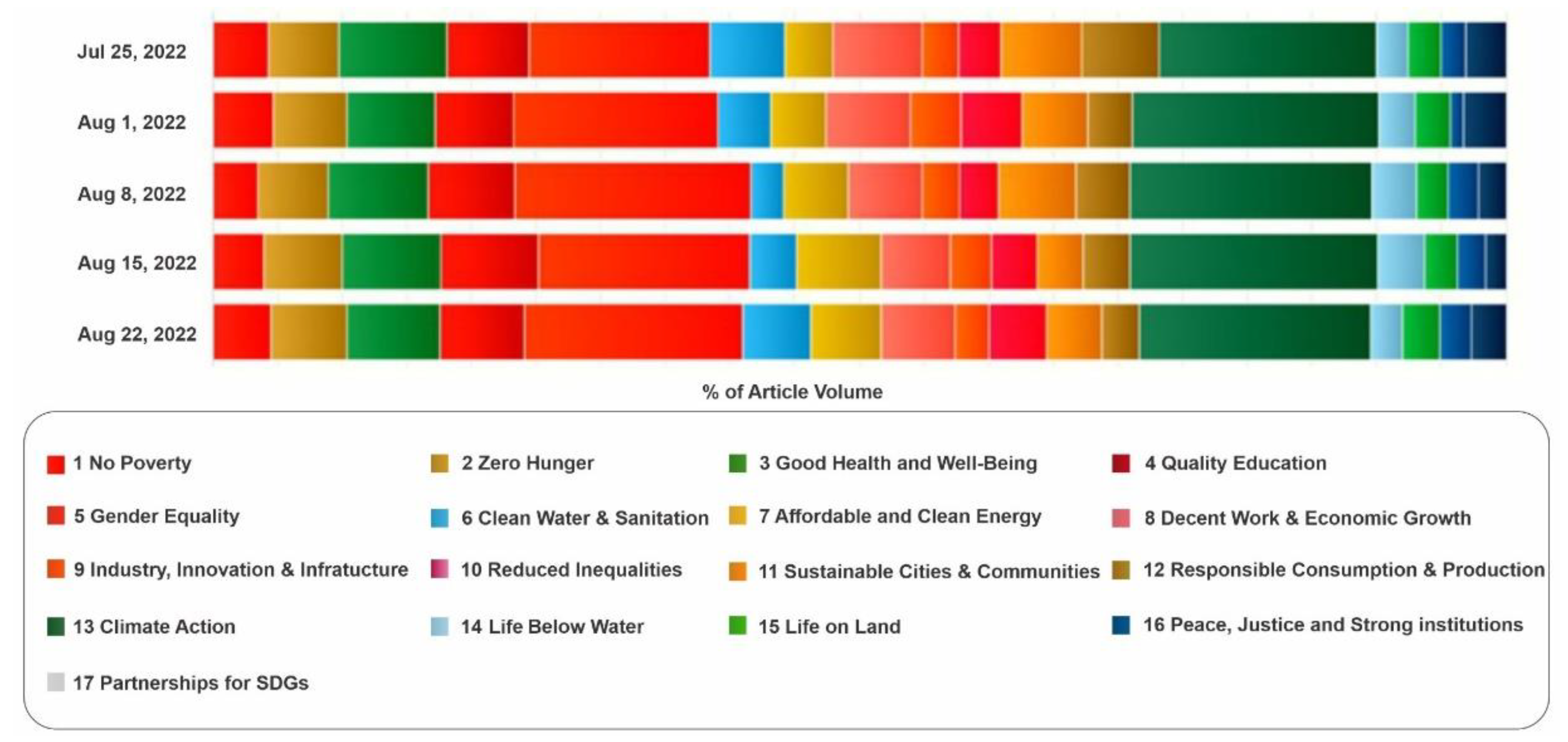
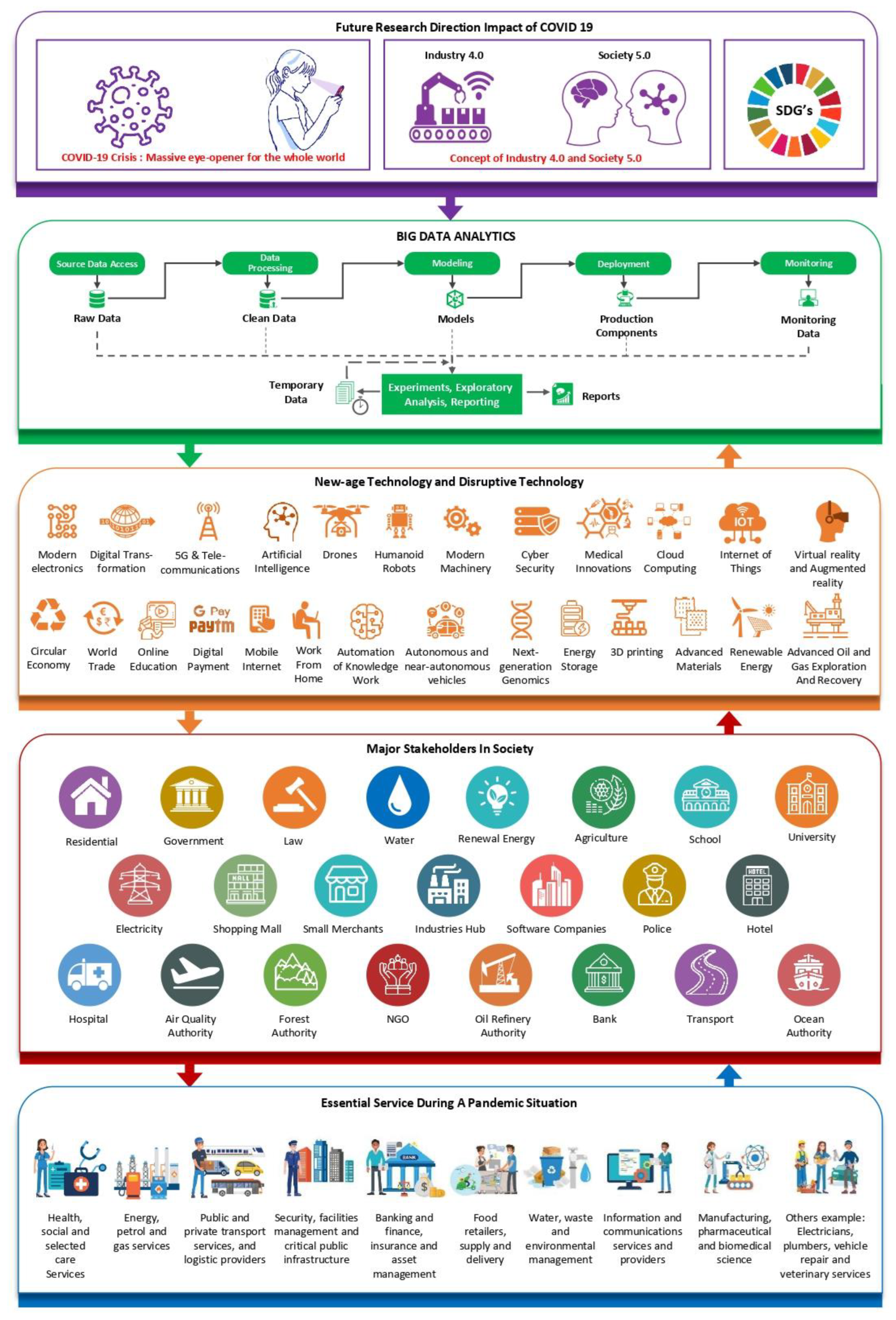

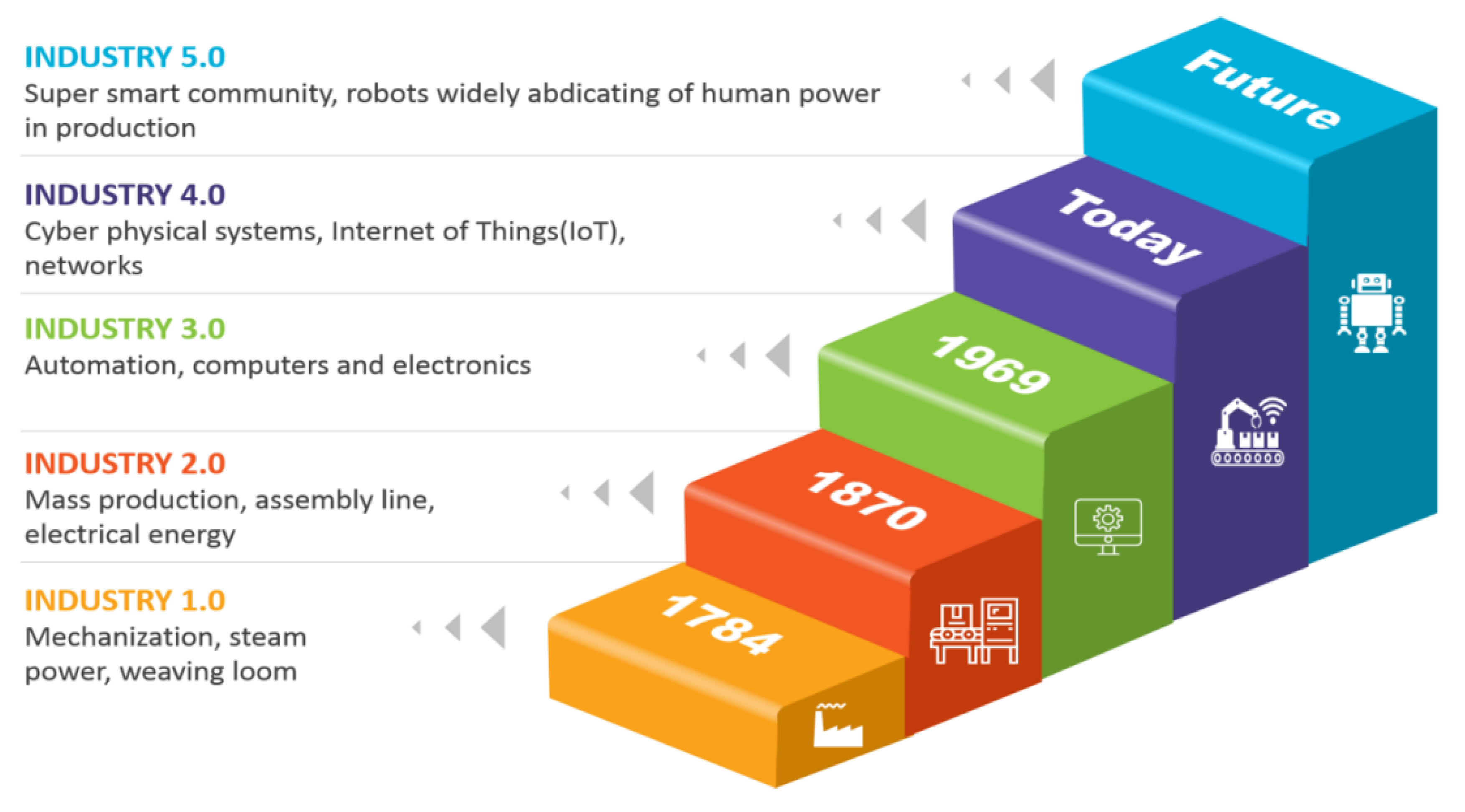
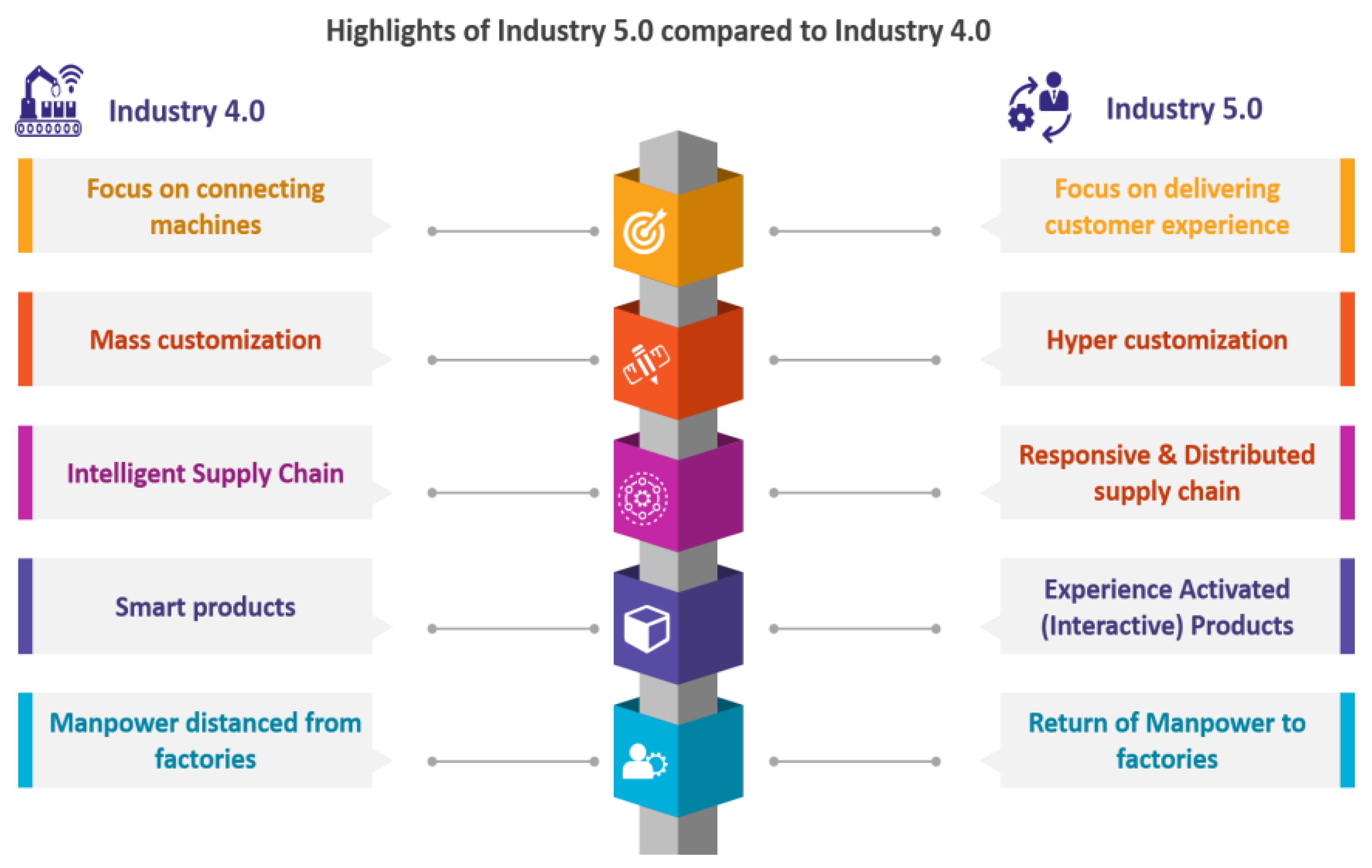
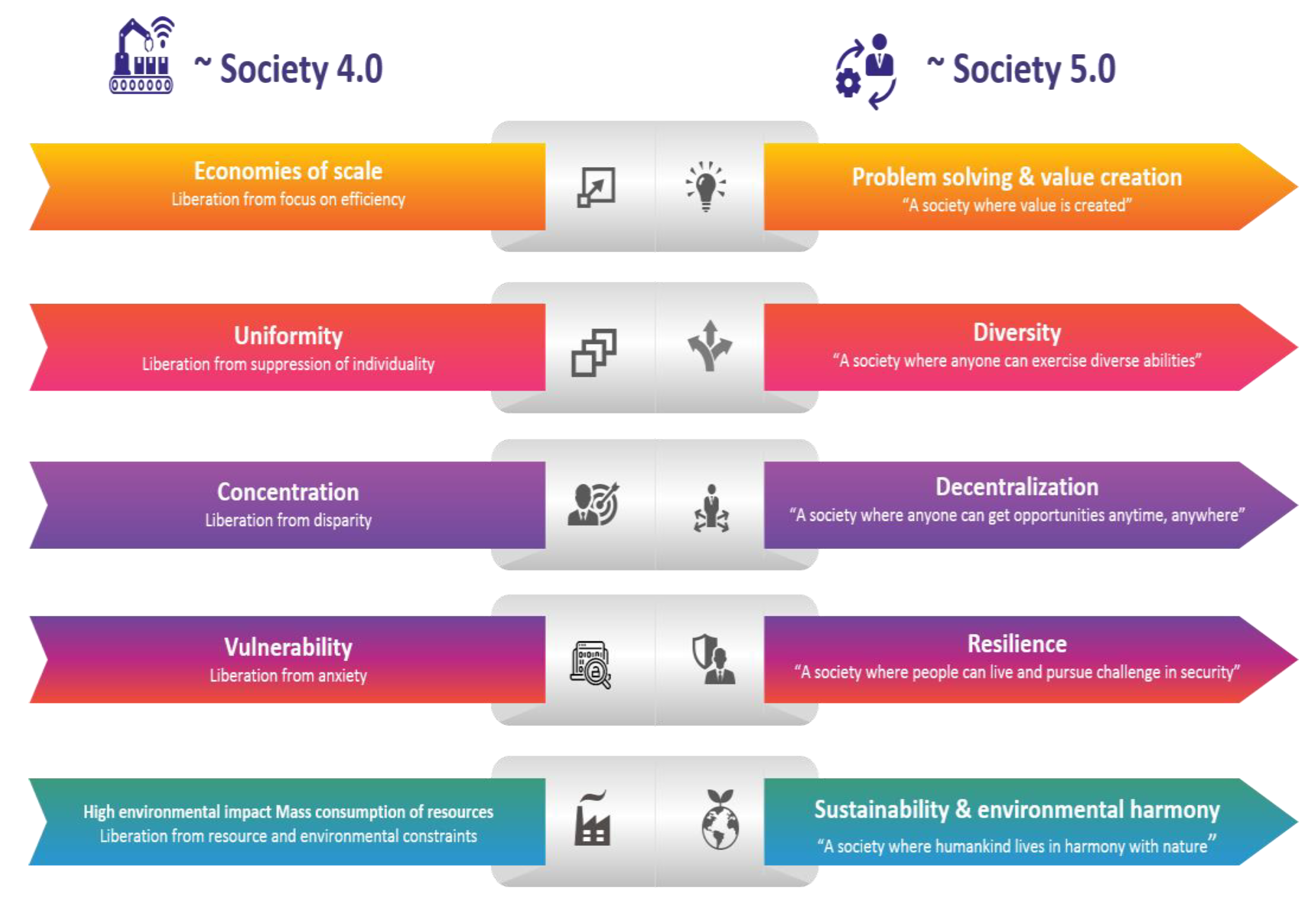
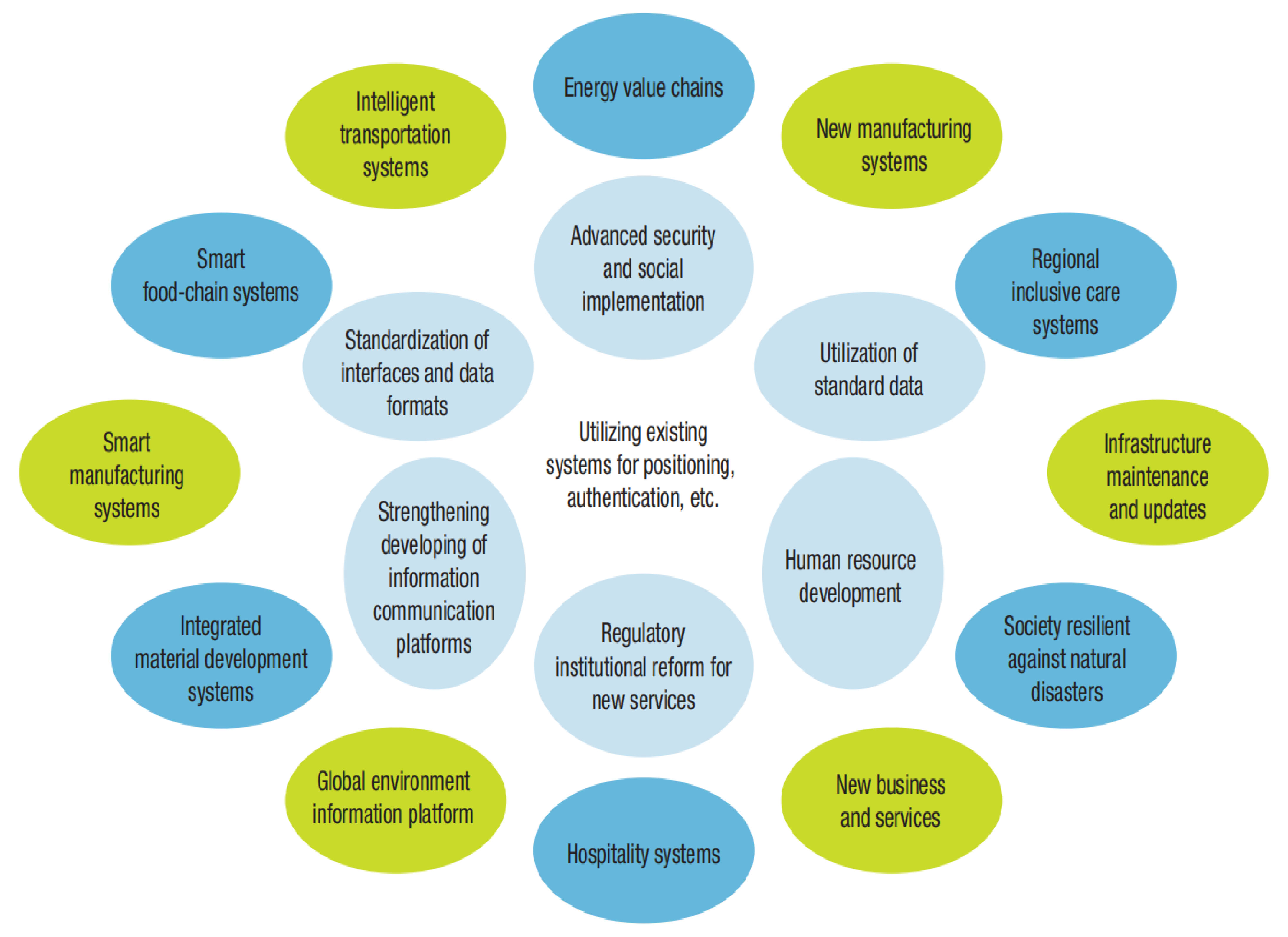

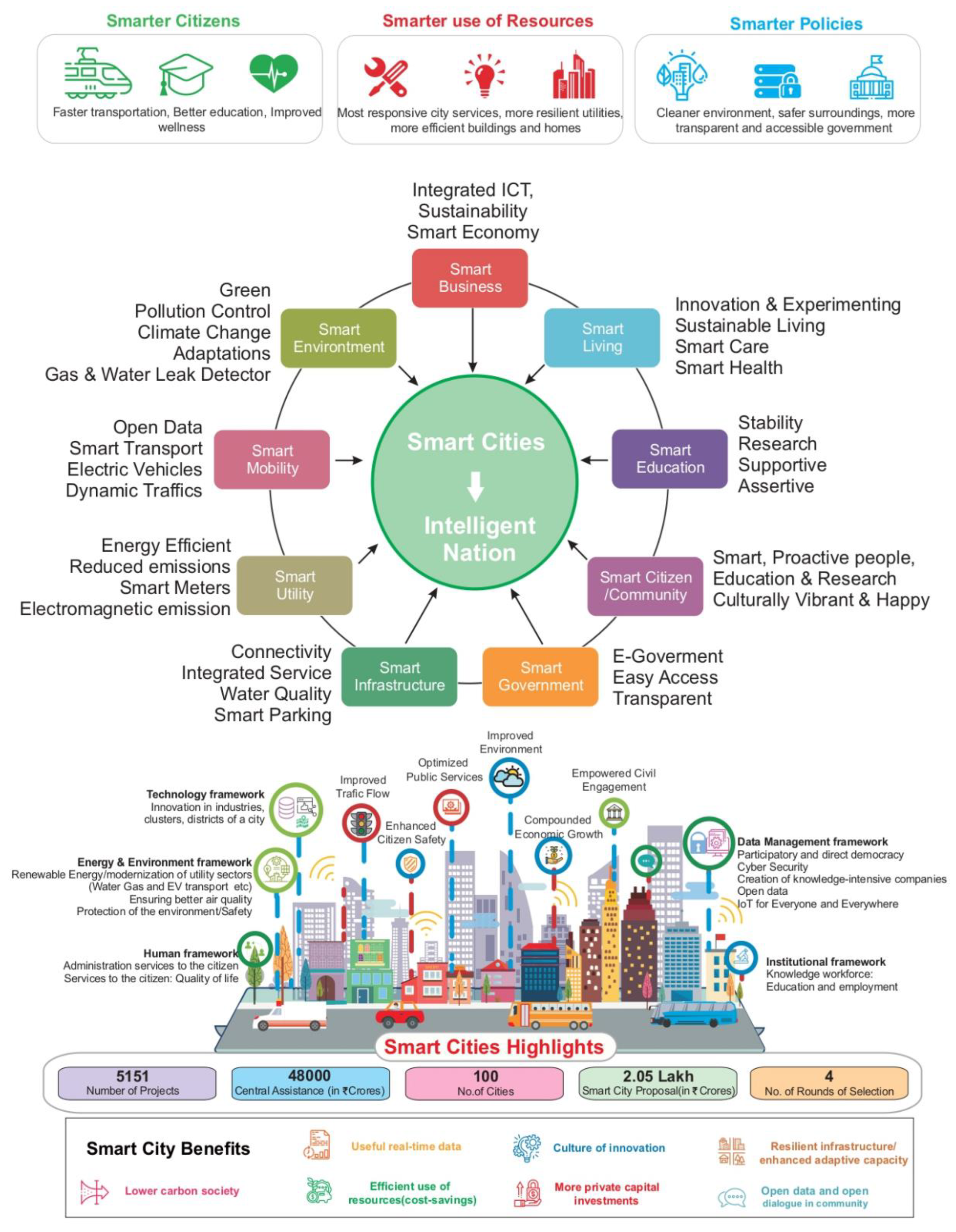
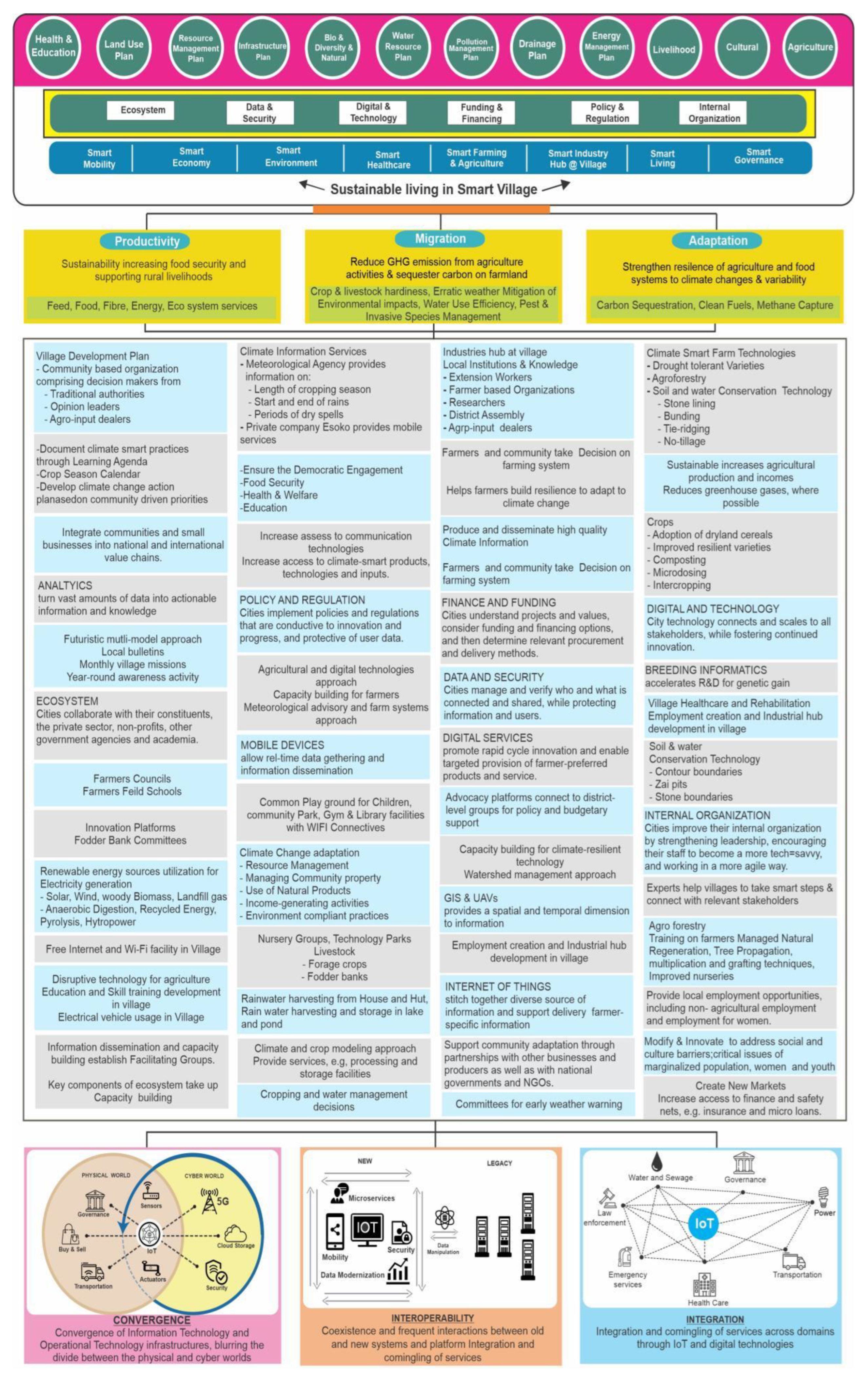



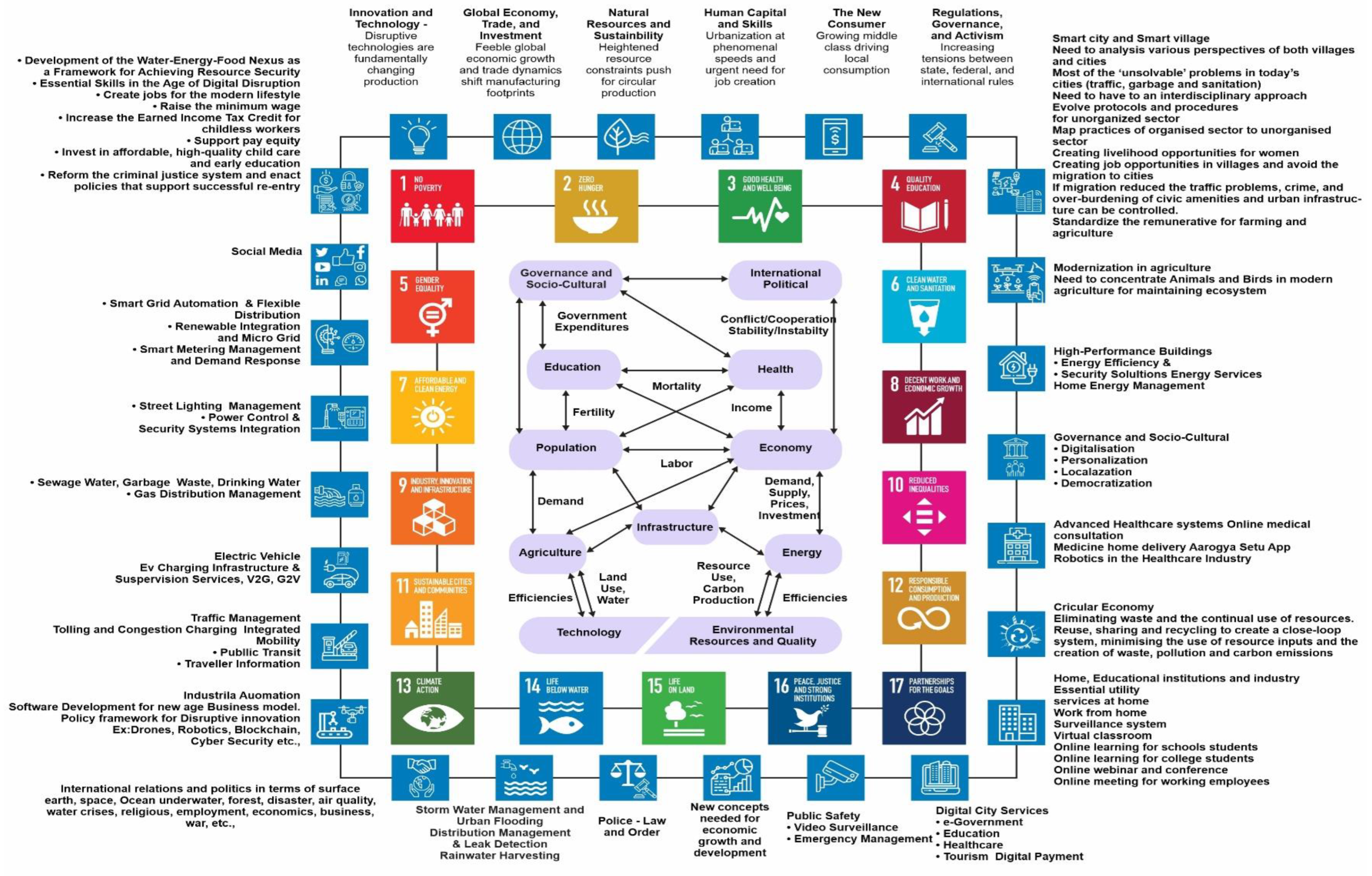
| SDG Goals | Disruptive Technologies Support |
|---|---|
| SDG 1 (No poverty) |
|
| SDG 2 (Zero hunger) |
|
| SDG 3 (Good health and Wellbeing) |
|
| SDG 4 (Quality education) |
|
| SDG 5 (Gender equality) |
|
| SDG 6 (Clean water and sanitation) |
|
| SDG 7 (Affordable and Clean energy) |
|
| SDG 8 (Decent work and Economic growth) |
|
| SDG 9 (Industry, Innovation and Infrastructure) |
|
| SDG 10 (Reduced inequalities) |
|
| SDG 11 (Sustainable cities and communities) |
|
| SDG 12 (Responsible consumption and production) |
|
| SDG 13 (Climate action) |
|
| SDG 14 (Life below water) SDG 15 (Life on land) |
|
| SDG 16 (Peace, Justice and strong institutions) |
|
| SDG 17 (Partnerships for the goals) |
|
| Strengths | Weaknesses |
|---|---|
|
|
| Opportunities | Threats |
|
|
Publisher’s Note: MDPI stays neutral with regard to jurisdictional claims in published maps and institutional affiliations. |
© 2022 by the authors. Licensee MDPI, Basel, Switzerland. This article is an open access article distributed under the terms and conditions of the Creative Commons Attribution (CC BY) license (https://creativecommons.org/licenses/by/4.0/).
Share and Cite
Kasinathan, P.; Pugazhendhi, R.; Elavarasan, R.M.; Ramachandaramurthy, V.K.; Ramanathan, V.; Subramanian, S.; Kumar, S.; Nandhagopal, K.; Raghavan, R.R.V.; Rangasamy, S.; et al. Realization of Sustainable Development Goals with Disruptive Technologies by Integrating Industry 5.0, Society 5.0, Smart Cities and Villages. Sustainability 2022, 14, 15258. https://doi.org/10.3390/su142215258
Kasinathan P, Pugazhendhi R, Elavarasan RM, Ramachandaramurthy VK, Ramanathan V, Subramanian S, Kumar S, Nandhagopal K, Raghavan RRV, Rangasamy S, et al. Realization of Sustainable Development Goals with Disruptive Technologies by Integrating Industry 5.0, Society 5.0, Smart Cities and Villages. Sustainability. 2022; 14(22):15258. https://doi.org/10.3390/su142215258
Chicago/Turabian StyleKasinathan, Padmanathan, Rishi Pugazhendhi, Rajvikram Madurai Elavarasan, Vigna Kumaran Ramachandaramurthy, Vinoth Ramanathan, Senthilkumar Subramanian, Sachin Kumar, Kamalakannan Nandhagopal, Raghavendra Rajan Vijaya Raghavan, Sankar Rangasamy, and et al. 2022. "Realization of Sustainable Development Goals with Disruptive Technologies by Integrating Industry 5.0, Society 5.0, Smart Cities and Villages" Sustainability 14, no. 22: 15258. https://doi.org/10.3390/su142215258
APA StyleKasinathan, P., Pugazhendhi, R., Elavarasan, R. M., Ramachandaramurthy, V. K., Ramanathan, V., Subramanian, S., Kumar, S., Nandhagopal, K., Raghavan, R. R. V., Rangasamy, S., Devendiran, R., & Alsharif, M. H. (2022). Realization of Sustainable Development Goals with Disruptive Technologies by Integrating Industry 5.0, Society 5.0, Smart Cities and Villages. Sustainability, 14(22), 15258. https://doi.org/10.3390/su142215258













